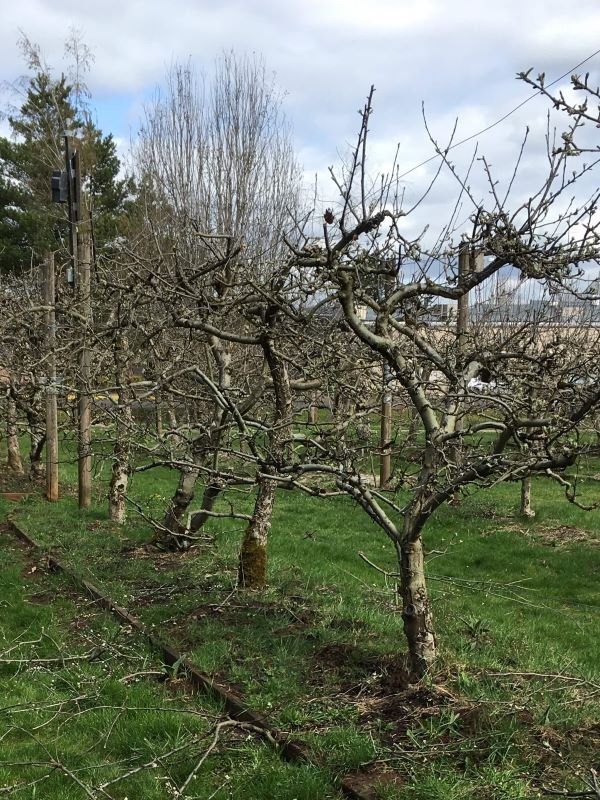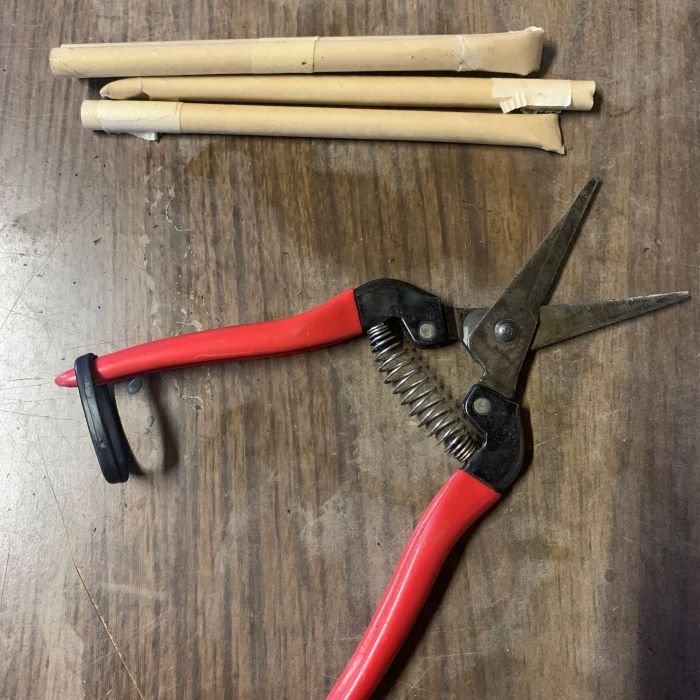WINTER: Orchard Care Task-List
DID YOU THINK WINTER WAS A TIME OF REST?
As we settle into the dormant season, (for the trees at least!) now feels like the perfect time to share a snapshot of our winter community orchard care routine.
So lace up your waterproof boots, and dig out your warmest gloves, because we’re climbing right in and won’t be stopping until bud break!
WINTER TASK LIST SUMMARY:
✔️ propagating
✔️ pruning
✔️ pollinator care
✔️ orchard health
✔️ scouting
✔️spraying (or not)
The orchard care outline that follows is a summary of tasks completed in the HOEC Arboretum each winter. Remember that your own site-specific task list should be adjusted based on your region, landscape, soil, pest & disease pressures, personal feelings about what organic or holistic growing means, as well as which varieties of fruit you are stewarding.
Your final product may be quite similar to ours or it could be very different. Either is okay. Now let’s dive in!
WINTER ORCHARD TASK LIST
PROPAGATION
Rootstocks set into damp medium in the shade awaiting early spring grafting.
Freshly cut and labeled scions drying off just enough to can wax each cut end.
Propagating dormant fig and elderberry cuttings.
🔲 If you didn’t do it in fall, now is the time to order rootstock for grafting if you can still find it available.
🔲 Cut & collect scions for future spring grafting from fully dormant fruit trees. The best time to collect here in the Pacific Northwest is usually between January and February, but avoid collecting on days when the temperature is below freezing.
🔲 Label and store scions in your fridge or cooler. Be sure to add some form of moisture such as a damp paper towel in the container to keep them from drying out. In the arboretum, we also use a “sealing wax” on the cut ends of the scions we intend to ship to help with moisture retention.
🔲 Take cuttings of other woody perennials for winter propagation. Tell yourself you will stop when you have generated a “reasonable” amount, but then continue collecting until there is nary a space left on your property to shimmy through.
🔲 Check on fall sown seeds or cuttings to ensure they are properly moist, well drained, free of mold, and safe from curious critters.
🔲 Begin hoarding seed & plant catalogues. *Place extra attention to choosing naturally pest & disease resistant varieties and those that will provide forage for spring and summer pollinators.
🔲 Place pre-orders of plants and seeds from your favorite suppliers if you haven’t done so already. Now is a great time to order your bare-root trees.
🔲 Check on stored scions weekly for signs of mold and ensure there is still adequate humidity in your storage space.
FREE RESOURCE LINK!
Scion Collecting Video Tutorial List, From Orchard Notes Blog:
PRUNING
🔲 Prune healthy apple, pear, quince, medlar, fig, and persimmon trees. In winter, pruning should focus on overall framework, damage repair, and larger branch removals. Creating a structure with limbs that are well-spaced for good airflow will also support disease reduction.
Note:
Winter (dormant season) pruning generally promotes vigorous re-growth, so if your tree needs an invigorating boost, winter is a great time to prune.
Summer pruning often slows growth, so if you hope to reduce height or slow growth in a highly vigorous tree, prune very lightly in winter or don’t prune at all and consider switching the majority of your pruning to summer.
If you find any cankers on limbs, (fire blight or others) take extra care to prune them out completely and burn any infected wood. Only remove cankers during periods of no rain. Cankers spread through openings such as pruning wounds and cold, wet, windy weather sets the stage for spread of infection.
You should be looking for and removing fire blight cankers and other signs of disease year round - not just in winter.
🔲 Prune grape and kiwi vines after the danger of hard frost has passed (usually late February to early March). You can prune earlier any time after they are dormant, but you risk killing off fruiting buds and spurs if an unexpected cold snap arrives later.
🔲 Skip The Stone Fruits: Stone fruits (plums, cherries, apricots, etc.) are highly susceptible to bacterial diseases that can be spread through pruning cuts and are exacerbated by wet or humid weather. To reduce the chance of infection, we hold off on winter pruning of stone fruits and wait to prune these in summer. This is especially important in an organic growing situation where your options for treatment of bacterial disease are limited.
FREE RESOURCE LINK!
Pruning Introduction & Instructional, From OSU Extension:
POLLINATOR CARE
Thinning snips used to gently cut open cardboard mason bee tubes.
Mason bee cocoons being washed in a sanitizing solution to kill contagious disease such as chalkbrood.
🔲 Complete mason bee cocoon removal, cleaning, and disinfecting if not already finished. (We like to save this project for very rainy days!)
🔲 Store mason bees safely in the fridge. Ensure they have an appropriate level of humidity, and airflow. Optimal cold storage conditions are between about 34-39°F and humidity between 60-70%.
🔲 Order bee tubes and liners for the following season or get alternative weather-proof and easy to disinfect mason bee housing in order.
Take inventory of pollinator friendly plants. Are there enough early bloomers for the first round of mason bees? Source seeds or make a list of plants needed to fill in any seasonal bloom gaps.
🔲 Check on stored mason bee cocoons weekly for signs of mold and to ensure the level of humidity is appropriate.
FREE RESOURCE LINK!
Mason bee cleaning & care tutorial, by HOEC:
ORCHARD HEALTH
“Fruit Mummy” hanging on the tree well into winter.
🔲 Remove fruit mummies from branches and the ground to lessen fungal spores. Fallen & mummified fruits often contain disease & large amounts of fungal spores such as scab. If left near your trees, they can dramatically increase future infections.
🔲 Remove pruning debris and leaves that came from your fruit trees with special attention to diseased or infected wood. Dispose of the prunings and mummies off site, in your curbside compost bin, as far from your fruit trees as possible, in a managed hot compost system at the opposite end of your property, or by closely monitored burning.
🔲 Make sure any mulch is pulled back at least 2” from the base of all trees.
🔲 Apply lime within the drip line of your fruit trees. Although most often applied in fall when rain will flush it into the soil, lime can be applied any time of year and is generally helpful for most soil types here in the Pacific Northwest. Do avoid applying lime under any acid loving plants such as blueberries.
🔲 Mulch, mulch, mulch. Mulch for added solid health, to lessen runoff, and to inhibit unwanted weed growth wherever there is bare soil or unwanted weed pressure.
FREE RESOURCE!
Orchard Hygiene Basics by HOEC
SCOUTING
Extremely important, but often overlooked!
A successful orchard steward always makes time for regular monitoring and deep observation of the orchard environment. We call these observational walks “scouting trips”. Scouting will help you learn to identify the challenges your orchard is facing and what it needs (or doesn’t need) from you at different times of the year. If you plan to implement any type of pest control measures in your orchard, this is the place you need to begin.
Optional winter scouting materials:
🔲 Notepad & pen
🔲 Camera
🔲 Pest & disease handbook or printouts with good color photos
🔲 Pruners, loppers, and a hand saw
🔲 Sanitizing spray
Take a walk through your orchard. You won’t see many pests this time of year as most will be overwintering in pupal forms tucked away into nooks and crannies. What you are looking for now are signs of disease or damage, such as:
❌ Wood damage from critters like rabbits and deer
❌ Branch breakage from from weather or heavy fruit
❌ Crown Rot, Collar Rot, & Root Rot
❌ Sun damage
Make note of the date, the weather conditions, the damage you find, the severity of damage, and snap a photo if you’d like to make your own reference booklet, or share your findings. If you found any damage that needs to be addressed overwinter, take care of it now or make sure to add it to your to-do list. If you find any cankers (fire blight or others) take extra care to prune them out completely and burn any infected wood.
FREE RESOURCE:
An extensive quick find database of crop pests, hosts, diseases, and problem weeds! This is a great resource to bookmark and refer to often.
PNW Insect, Plant Disease, & Weed Management Online “Handbook”
TO SPRAY OR NOT TO SPRAY?
When you hear the term “spraying” in regard to fruit trees, you may think of some sort of liquid chemical sprayed over a tree that magically kills all pests and diseases on contact, resulting in “perfect” grocery store quality fruit.
In reality - and especially in organic orcharding, there is no such magic potion. Increasing the percentage of human grade fruit requires approaching orchard health from many different angles. Covering your trees with supplemental and preventative sprays is only one part of a larger holistic picture for you to consider. If your pest and/or disease pressure is high, it may be necessary to spray if you want to have edible fruit. just remember - there is such a thing as too much intervention. When thinking about a spray routine, you’ll want to aim for a “reasonable threshold” in terms of pest presence instead of total annihilation, or you will end up with much bigger problems!
SPRAYS FOR USE IN WINTER:
Nourishing Sprays & Horticultural Oils
Nourishing sprays: These are ingredients that support nutrition, stimulate immune response, and reduce stress within the plant itself. The intent of these individual ingredients or mixtures is to help the tree become better equipped to fight off pests and disease on its own.
Examples: Kelp, Liquid fish, Blackstrap Molasses, Compost & Vermiculture Teas.
Nourishing sprays are safe to apply any time in the dormant season, but will have the most benefit just when buds begin to show green but before blooms are present.
Dormant / Horticultural Oils: Horticultural oils applied in the dormant season (winter) are intended to smother overwintering pests. Different types of horticultural oils have different effects on targeted pest insects. They may repel, kill, or interfere with metabolism and feeding. Oil applications in the orchard in the dormant season help control aphids, mites, and scale insects.
There is a short window of time when dormant oils must be applied to be safe and effective.
IMPORTANT NOTE: Always look up specific timing (of year and of day), dilution, and application instructions for each product and follow manufacturer instructions very carefully. Some products can safely be mixed or applied together, and others must stay separate to be both safe and effective. Some are phytotoxic (will burn leaves if there is sun or heat present) and others will harm pollinators if applied when they are active. Taking time to read and follow instructions will help you grow better fruit and protect other creatures in your orchard.
FREE RESOURCES!
Pacific Northwest Plant Management Handbooks - the same website as mentioned in the previous section is where it’s at! You can search there for many types of fruits and then narrow it down to specific pests or diseases, and they will give you specific advice on both chemical and biological controls that might be considered for each issue:
https://pnwhandbooks.org/insect/tree-fruit/apple
https://pnwhandbooks.org/insect/tree-fruit/pear
If you’d like to learn more about managing your fruit trees naturally and you live in the area - please join us for a Hands-on Workshop in the HOEC Community Orchard! Our winter pruning workshops series begin in January. :)
Happy Orcharding All! 🎉


















